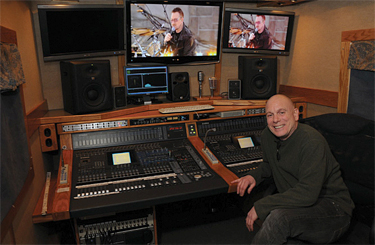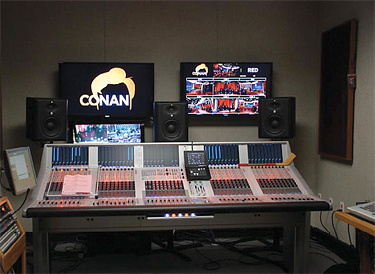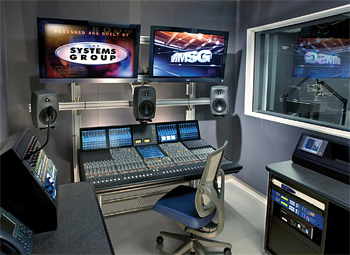Making Music on TV
LOS ANGELES—Music and entertainment productions for television broadcast place somewhat different demands on a mixing console compared to sports or news programming. Indeed, the functionality and facilities required might typically be more akin to those demanded in recording or live sound applications.
GMA SUMMER CONCERT SERIES

JC Convertino, head music mixer for in-studio and outdoor performances on "Good Morning America," has long favored Yamaha's DM2000 digital console. JC Convertino, head music mixer for in-studio and outdoor performances on "Good Morning America" and other ABC programs for nearly 12 years, has long favored Yamaha's DM2000 digital console. Convertino uses a pair of cascaded DM2000s, typically in Ringwood, N.J.-based mobile recording studio provider Record Plant Remote's RV or the Remote Recording Services truck, to mix the high-profile artists that appear on GMA's annual Summer Concert Series, as well as various specials and one-off concerts.
The consoles handle 96 inputs and are equipped with Yamaha AD8 HR remote mic preamp/converters linked from the stage via LightViper fiber. Convertino generally has little need for outboard processing. "The Yamaha DM2000 comes pretty well stacked with effects," explains Convertino, whose background includes more than 30 years at The Hit Factory, Sigma Sound and other studios.
Convertino is well prepared, reaching out to band producers and engineers well ahead of a performance to ensure that all the technical loose ends are tied up. "With live music segments on an early morning show, time is a factor. We don't have the luxury of a long rehearsal or sound check with the time it takes for load in, usually around midnight, building the stage, working with the live production team—a pleasure to work with, by the way—and on-air by 7:00 a.m."
Some artists can be a challenge; Black Eyed Peas, on the 2010 series, required 90 inputs. But the digital console system's functionality can be very useful: "On a remote gig like U2 and using the DM2000 that recalls everything, we had different delay times for each song for [singer] Bono, and when the recall is up, it's there, it's wonderful," he says of the special 2009 performance from Fordham University on GMA.
At ABC's midtown Manhattan studio, Convertino specified an analog setup, an API Legacy console, "which I love—and so do most of the bands that come in. I really wanted to go with more of a classic analog approach, something more musical."
CONNECTIVITY ON 'CONAN'
Paul Sandweiss, president of Sound Design Corp., which maintains post production facilities in Hollywood, also consults on projects such as—most recently—production facilities for "Conan," the new late-night talk, music and entertainment show hosted by Conan O'Brien on TBS. Produced on Stage 15 at Warner Bros. Studios in Burbank, Calif., "Conan" utilizes a pair of new Studer Vista 9 digital consoles.

TBS's "Conan" uses Studer Vista 9 digital consoles. Sandweiss previously worked with "Conan" producer Jeffrey Ross on the audio facilities for the comedian's short-lived "Tonight Show" stint on NBC, which included a Vista 8 desk. This time around, Ross hired Sandweiss to design and supply all the production audio, which included a music mix room, sound effects room, and a production mix room, interfacing with NEP's video and transmission designs.
The big advantage to installing a Vista 9 for both music and production, notes Sandweiss, was the connectivity. "If you put the cores close together you get 96 channels of AES I/O, and it's just a connector; there's no MADI cards, no additional cost. That gave us a common MADI stream, so we have redundant backup."
Plus, he says, "I didn't want a room with 40 feet of patchbay. I wanted minimal patchbay connectivity for any outboard gear, or guest outboard gear that might show up."
Sandweiss put Fairlight systems in the production and music rooms as recorders. As with most late-night talk shows, there is a brief turnaround—"fix-it time"—between taping and air. "Now that you've recorded in both places and you have a commonality, the music mixer can start doing fixes while the production mixer is doing fixes and they can meet at the same place," he notes.
To work around the lengthy permitting process associated with building construction, Sandweiss worked with Dave Cravelli (who also built Sound Design), who had three 60-foot trailers built. "Once onsite the main trailer became the control room, transmission room, audio production, sound effects, voiceover and deco, all built into one huge facility," Sandweiss said. "We built a separate trailer for the music mix." ATK AudioTek provided the audience sound system.

MSG Media recently added a third Solid State Logic digital console at its studios near Madison Square Garden arena. Fibre connectivity to the stage, over 500 feet away, made placement of the Studer remote-controlled mic preamps on the stage a "no-brainer," according to Sandweiss.
An important factor in the purchase decision, he says, was sex appeal. "It's psychoacoustics. When an engineer walks into a room, a lot of the sound is based on the appearance of the hardware that's sitting in the room. The new Vista 9, if you see it lit up with the FaderGlow and everything, it's pretty sexy!"
MSG STREAMLINES
MSG Media, which encompasses the MSG channel, MSG Plus and Fuse, recently added a third Solid State Logic digital console, a 32-fader C100 HDS, along with two Alpha-Link Live I/O units and an extensive MORSE Router system with Stage Boxes, at its studios near Madison Square Garden arena. MSG Media has additionally installed a Stage Box outside its Penn Plaza complex for interviews under the Fuse sign.
According to Michael Mitchell, chief engineer for MSG Media, "We have an extremely demanding production and post production schedule, and the SSL consoles afford us very worthwhile efficiencies for our different programming missions. They also consistently deliver great sound."
The three audio control rooms feed two production studios within the Penn Plaza complex, and are fibre-connected to two studios in the arena. The new studio is a utility room for live audio mixes, voiceovers and SAP, handling, for example, a sub-mix feed to one of the two main control rooms when the Fuse music channel hosts a live show. All three rooms are interconnected via SSL's MORSE routing and audio asset sharing system.
"We have tied our audio assets together to all of the production aspects of Fuse, MSG Network and MSG Plus, in such a way that from any room, anybody can do whatever they need to do," Mitchell explains.
"This allows us to streamline our studio scheduling. We've gone to great lengths to make sure the consoles offer the same configurations and resources so the engineering staff can move between studios efficiently."
Get the TV Tech Newsletter
The professional video industry's #1 source for news, trends and product and tech information. Sign up below.
Steve Harvey began writing for Pro Sound News and Surround Professional in 2000 and is currently senior content producer for Mix and a contributor to TV Tech. He has worked in the pro audio industry—as a touring musician, in live production, installed sound, and equipment sales and marketing—since November 1980.
